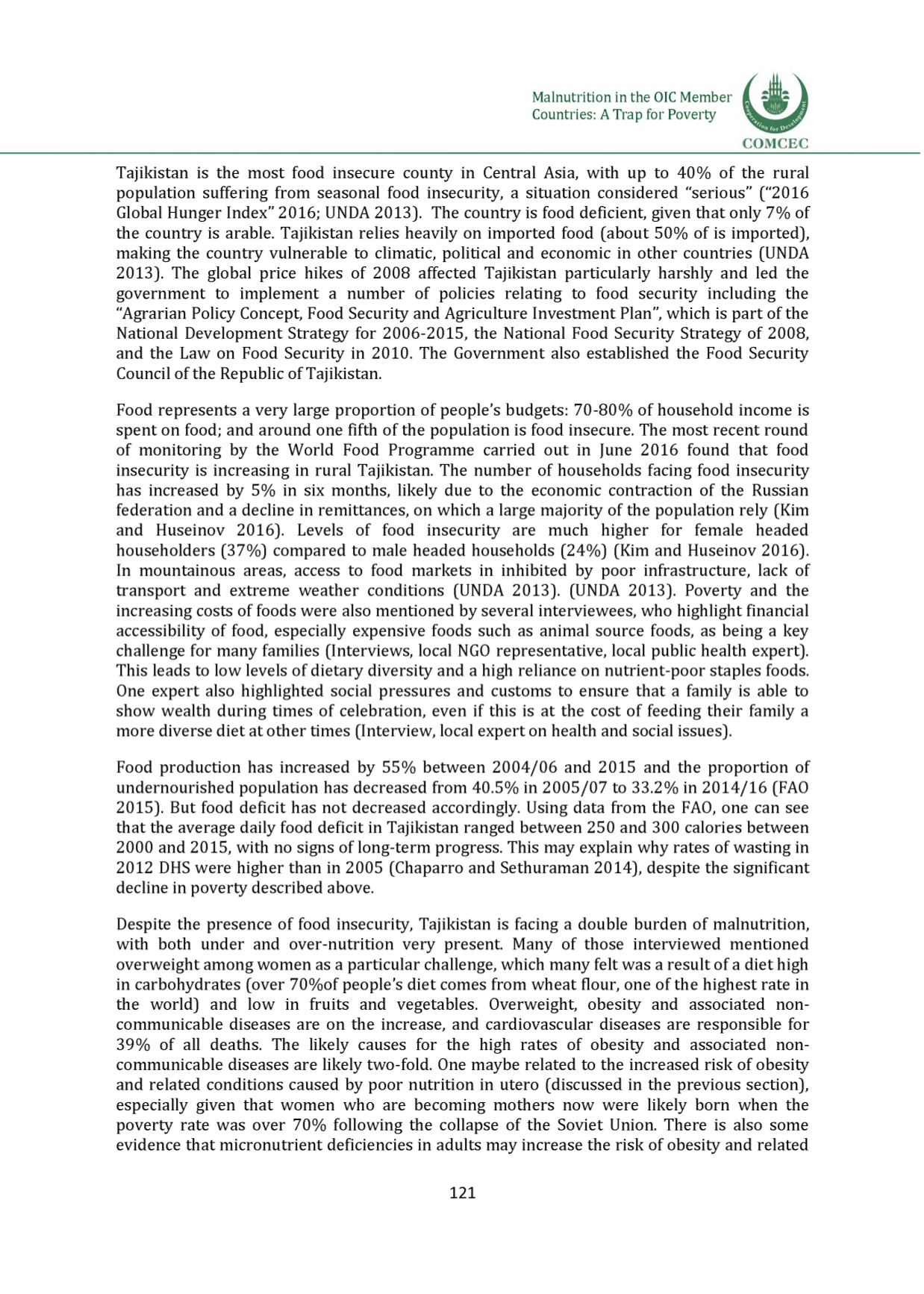

Malnutrition in the OIC Member
Countries: A Trap for Poverty
Tajikistan is the most food insecure county in Central Asia, with up to 40% of the rural
population suffering from seasonal food insecurity, a situation considered “serious” (“2016
Global Hunger Index” 2016; UNDA 2013]. The country is food deficient, given that only 7% of
the country is arable. Tajikistan relies heavily on imported food (about 50% of is imported),
making the country vulnerable to climatic, political and economic in other countries (UNDA
2013). The global price hikes of 2008 affected Tajikistan particularly harshly and led the
government to implement a number of policies relating to food security including the
“Agrarian Policy Concept, Food Security and Agriculture Investment Plan”, which is part of the
National Development Strategy for 2006-2015, the National Food Security Strategy of 2008,
and the Law on Food Security in 2010. The Government also established the Food Security
Council of the Republic of Tajikistan.
Food represents a very large proportion of people's budgets: 70-80% of household income is
spent on food; and around one fifth of the population is food insecure. The most recent round
of monitoring by the World Food Programme carried out in June 2016 found that food
insecurity is increasing in rural Tajikistan. The number of households facing food insecurity
has increased by 5% in six months, likely due to the economic contraction of the Russian
federation and a decline in remittances, on which a large majority of the population rely (Kim
and Huseinov 2016). Levels of food insecurity are much higher for female headed
householders (37%) compared to male headed households (24%) (Kim and Huseinov 2016).
In mountainous areas, access to food markets in inhibited by poor infrastructure, lack of
transport and extreme weather conditions (UNDA 2013). (UNDA 2013). Poverty and the
increasing costs of foods were also mentioned by several interviewees, who highlight financial
accessibility of food, especially expensive foods such as animal source foods, as being a key
challenge for many families (Interviews, local NGO representative, local public health expert).
This leads to low levels of dietary diversity and a high reliance on nutrient-poor staples foods.
One expert also highlighted social pressures and customs to ensure that a family is able to
show wealth during times of celebration, even if this is at the cost of feeding their family a
more diverse diet at other times (Interview, local expert on health and social issues).
Food production has increased by 55% between 2004/06 and 2015 and the proportion of
undernourished population has decreased from 40.5% in 2005/07 to 33.2% in 2014/16 (FAO
2015). But food deficit has not decreased accordingly. Using data from the FAO, one can see
that the average daily food deficit in Tajikistan ranged between 250 and 300 calories between
2000 and 2015, with no signs of long-term progress. This may explain why rates of wasting in
2012 DHS were higher than in 2005 (Chaparro and Sethuraman 2014), despite the significant
decline in poverty described above.
Despite the presence of food insecurity, Tajikistan is facing a double burden of malnutrition,
with both under and over-nutrition very present. Many of those interviewed mentioned
overweight among women as a particular challenge, which many felt was a result of a diet high
in carbohydrates (over 70%of people's diet comes from wheat flour, one of the highest rate in
the world) and low in fruits and vegetables. Overweight, obesity and associated non
communicable diseases are on the increase, and cardiovascular diseases are responsible for
39% of all deaths. The likely causes for the high rates of obesity and associated non
communicable diseases are likely two-fold. One maybe related to the increased risk of obesity
and related conditions caused by poor nutrition in utero (discussed in the previous section),
especially given that women who are becoming mothers now were likely born when the
poverty rate was over 70% following the collapse of the Soviet Union. There is also some
evidence that micronutrient deficiencies in adults may increase the risk of obesity and related
121
















